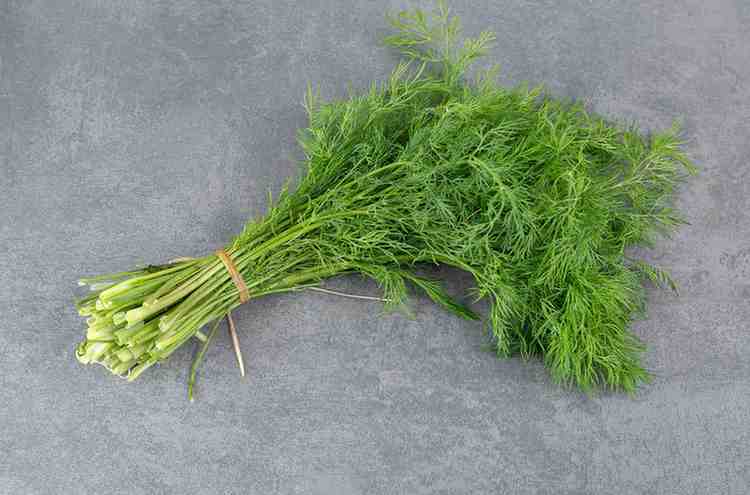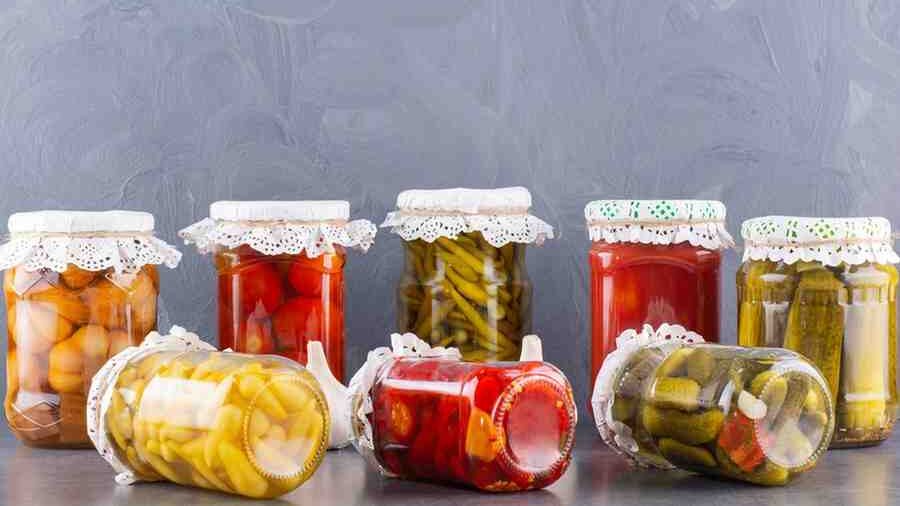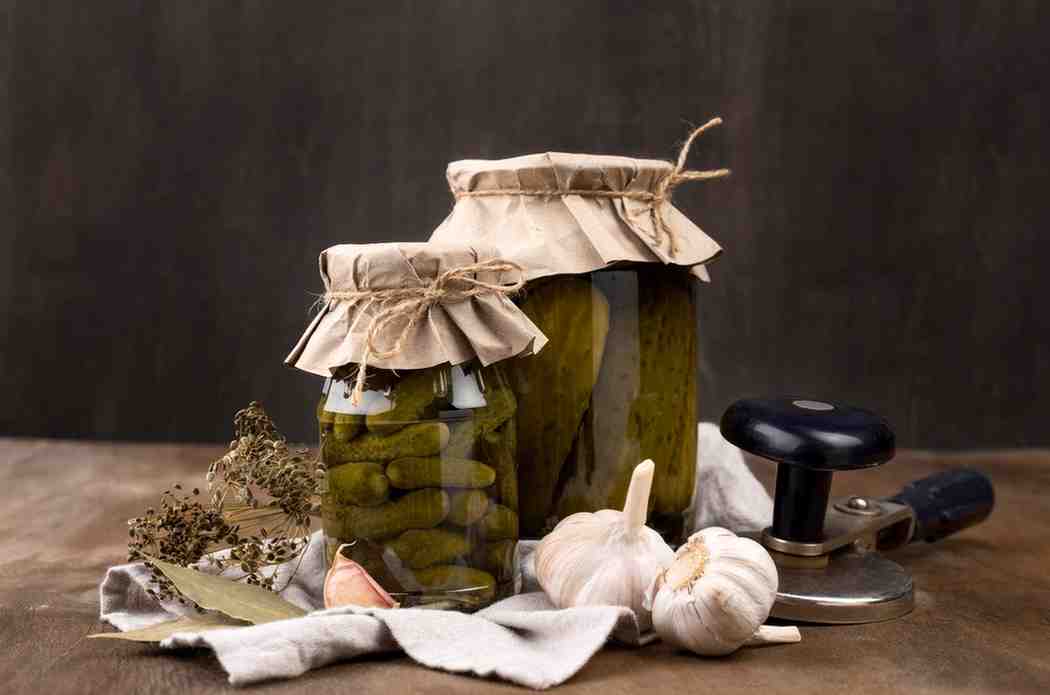Russian pickling spice, featuring dill (known as Ukrop in Russian), forms the heart of authentic Russian dill pickles. This unique blend combines fresh dill, garlic, black peppercorns, and bay leaves in a saltwater brine that naturally ferments the cucumbers, creating a tangy, crisp, and aromatic flavor. Unlike vinegar-based pickling, natural fermentation with dill adds a distinct taste, making it a favorite in traditional Russian cuisine.
Key Ingredients for Ukrop Pickling Spice
Essential Ingredients and Their Roles
- Dill (Fresh or Flowered Heads): Dill is the foundation of Russian pickling, offering an aromatic and slightly grassy flavor. It brings freshness and depth to the brine. Using flowered heads of dill, if available, enhances the aroma, making the pickles taste even more authentic and vibrant. Dill heads provide natural oils that blend seamlessly with the brine, ensuring the flavor permeates every cucumber.
- Garlic: Known for its strong, pungent flavor, garlic balances the herbal notes of dill with a savory edge. Slightly crushed garlic cloves release their full aroma, which infuses the brine over time. This addition gives the pickles a bold taste and helps cut through the acidity, enhancing the overall balance of flavors.
- Black Peppercorns: Adding black peppercorns gives the brine a subtle heat without overwhelming the other ingredients. Whole peppercorns release their flavor gradually during fermentation, offering a mild spiciness and an earthy undertone. This addition enhances the depth and complexity of the pickling spice.
- Pickling Spices (Coriander Seeds, Mustard Seeds, Bay Leaves, Pepper Flakes):
- Coriander Seeds: These seeds add a gentle citrus note, brightening the brine and balancing the earthy spices.
- Mustard Seeds: Mustard seeds bring a hint of tangy spice, which intensifies the flavor as the pickles ferment.
- Bay Leaves: Bay leaves introduce a soft, earthy aroma that rounds out the brine. Their gentle, herbal notes meld well with dill and garlic.
- Pepper Flakes (Optional): For a slightly spicier brine, add red pepper flakes. They give the pickles a mild kick, which works well with meats or charcuterie boards.

Optional Ingredients for Extra Flavor and Crunch
- Leaves (Grape, Black Currant, Cherry): Leaves from grape, black currant, or cherry plants are traditional additions that serve two purposes: they help maintain the pickles’ crispness due to their tannins and add a mild earthy flavor. Including a few of these leaves in the jar gives a slightly rustic, forest-like aroma, enhancing the pickling experience.
- Horseradish Root: Horseradish root, sliced thinly, provides a peppery note and helps keep the cucumbers crunchy. It adds a spicy undertone that complements the garlic and dill, making the pickles bolder in flavor.
Step-by-Step Guide to Making Russian Dill Pickles
1. Prepare the Brine
The brine is essential for both preserving and flavoring the pickles. A simple saltwater solution creates the ideal environment for fermentation.
- Ingredients: Use 4 cups of water and 2 tablespoons of non-iodized salt (such as kosher or sea salt).
- Instructions:
- Bring the water to a gentle boil, then add the salt. Stir until it dissolves completely.
- Let the brine cool to room temperature. Cooling is crucial because hot brine can soften the cucumbers, affecting their crunch.
2. Prepare the Cucumbers
Choosing and prepping cucumbers correctly makes a big difference in the pickles’ texture and flavor.
- Selecting Cucumbers: For the best pickles, select small, firm cucumbers, ideally 3-4 inches long. Smaller cucumbers tend to stay crunchier during fermentation.
- Preparation Steps:
- Wash cucumbers thoroughly under cold water.
- Trim off both ends, particularly the blossom end, which contains enzymes that can soften the pickles. Removing this ensures a crisp texture.
- For quicker fermentation, make a few small cuts or pricks on each cucumber, allowing the brine to penetrate more effectively.
3. Arrange Ingredients in the Jar
Proper layering in the jar enhances flavor distribution, ensuring the pickles absorb the spices evenly.
- Layer Spices and Aromatics:
- Place a few sprigs of dill, garlic cloves, and a portion of the pickling spices (coriander seeds, mustard seeds, and black peppercorns) at the bottom of a clean glass jar.
- Add one or two bay leaves and a few grape or black currant leaves (if using) for extra crispness.
- Pack the Cucumbers:
- Arrange the cucumbers upright in the jar, packing them tightly to minimize empty spaces. Packing the cucumbers tightly prevents floating and ensures they stay submerged in the brine.
- Top with Remaining Spices:
- Add more dill, garlic, and pickling spices on top of the cucumbers to intensify the flavor as the pickles ferment.
4. Pour the Brine
Pour the cooled brine over the cucumbers until they are fully submerged.
- Tips for Submersion:
- To keep the cucumbers submerged, place a small weight (such as a clean glass weight or plate) on top. This prevents any exposure to air, reducing the risk of mold and ensuring an even fermentation.
5. Start the Fermentation Process
Fermentation brings out the flavors and transforms the cucumbers into tangy, crunchy pickles.
- Seal and Store:
- Place a lid on the jar, either loosely (to allow gases to escape) or fitted with an airlock. Let the jar sit at room temperature, ideally in a cool, dark place.
- Allow the cucumbers to ferment for at least 3 days. For a stronger flavor, extend the fermentation period to a week or even up to two weeks.
- Check and Taste:
- After 3 days, taste one cucumber to test the flavor. If it needs more time, let it ferment a few days longer. When it reaches your desired taste, move the jar to the refrigerator to halt the fermentation process and keep the pickles fresh.
6. Storage and Serving
Once fermented, store the pickles in the refrigerator. They stay fresh for up to six months and continue to develop flavor over time.
- Serving Suggestions:
- Russian dill pickles add a tangy, crunchy bite that pairs well with hearty meals, sandwiches, or even on a charcuterie board.
- Enjoy them as a standalone snack or alongside traditional Russian dishes like borscht and pelmeni.

Flavor Profile and Culinary Uses of Russian Pickling Spice
Russian Pickling Spice (Ukrop): A unique blend featuring fresh dill, garlic, and spices, creating a tangy, crisp pickle through natural fermentation.
- Earthy dill with garlic, black peppercorns, and mustard seeds
- Lacto-fermentation in saltwater brine, no vinegar needed
- Traditional Russian flavor—aromatic, tangy, and crisp
Traditional Uses in Russian Cuisine
In Russian cooking, Ukrop is most commonly used for pickling cucumbers, but it’s also a versatile spice mix for other fermented foods. Here’s a look at some traditional uses:
- Dill Pickles: Russian dill pickles, known for their crisp texture and rich, natural flavor, owe their unique taste to Ukrop. The cucumbers absorb the aromatic qualities of dill, garlic, and spices, creating a pickle that’s perfect on its own or as a side.
- Pickled Tomatoes: Tomatoes pickled with Ukrop develop a soft texture with an intensely tangy and slightly sweet flavor. The brine complements the natural acidity of tomatoes, making them a popular addition to Russian meals.
- Pickled Vegetables: Beyond cucumbers and tomatoes, Ukrop can be used to pickle carrots, cabbage, and bell peppers. The combination of spices works well with various vegetables, bringing a zesty, fermented flavor that enhances both taste and preservation.
Creative and Modern Uses
Ukrop’s flavor profile makes it suitable for creative recipes beyond traditional Russian pickling. Here are a few ideas to try:
- Seasoned Roasted Vegetables: Use a pinch of Ukrop spices, including dill, garlic, and pepper, to season roasted vegetables like potatoes, carrots, or Brussels sprouts. This brings the pickling spice’s earthy flavor to roasted dishes, creating a new twist on familiar vegetables.
- Savory Marinades: Incorporate Ukrop spices into a marinade for chicken, pork, or fish. The dill and garlic add a fresh, savory depth, especially when paired with lemon juice or olive oil. This works well for grilling or oven-baking, giving the meat a tangy flavor similar to the pickling process.
- Herbed Salads: Sprinkle Ukrop over cold salads for a unique kick. The flavors of dill and garlic complement ingredients like cucumber, tomato, and feta, adding a taste reminiscent of pickles without the fermentation.
- Infused Oils: Make a simple dill and garlic-infused oil using Ukrop spices. Add a few dill sprigs, garlic cloves, and peppercorns to olive oil, letting it sit for a few days. The result is a flavorful oil perfect for drizzling over bread, pasta, or grilled vegetables.
Health Benefits of Ukrop Ingredients
Ukrop doesn’t just add flavor; it also provides nutritional benefits, thanks to its mix of herbs and spices. The natural fermentation process in pickling can further support gut health, making this spice mix both tasty and functional.
Nutritional Benefits of Key Ingredients
- Dill: Dill is high in antioxidants and vitamins like A and C, which support immune health. It also contains calcium and iron, which benefit bone health. Dill’s natural compounds may support digestion and reduce bloating.
- Garlic: Known for its immune-boosting properties, garlic is rich in antioxidants and sulfur compounds, which may reduce inflammation and support heart health. It adds not only flavor but also provides antimicrobial benefits.
- Black Peppercorns: These contain antioxidants and compounds that aid digestion and may support metabolic health. Black pepper enhances nutrient absorption, making it a valuable addition to the pickling spice.
- Mustard Seeds: These seeds contain beneficial fats, minerals, and antioxidants. Mustard seeds support digestion and have antibacterial properties, which can help preserve the pickled vegetables.
- Bay Leaves: Bay leaves are rich in antioxidants and may help reduce inflammation. They support digestion and offer a mild herbal aroma that rounds out the flavor of the pickles.
Including Ukrop in your diet not only enhances flavor but can also provide valuable nutrients and support overall health. When paired with a naturally fermented brine, the probiotics from the pickling process contribute to a healthy gut.
Tips for Perfecting Your Ukrop Pickling Spice
Creating the ideal Ukrop blend involves attention to detail. Follow these tips to ensure a balanced flavor, ideal texture, and optimal preservation for your pickles.
- Use Fresh Ingredients: Fresh dill, garlic, and spices ensure maximum flavor. Dried or stale herbs can result in a flat taste, so whenever possible, use fresh dill sprigs and newly ground spices.
- Choose the Right Cucumbers: Smaller, firm cucumbers (3–4 inches) tend to hold up better in the brine. Their size and texture allow for full flavor absorption without becoming too soft.
- Experiment with Additional Leaves: If you want extra crunch, add grape, cherry, or black currant leaves. Their tannins help maintain crispness and introduce mild, earthy flavors.
- Monitor Fermentation Timing: For mild pickles, a 3-day fermentation is usually enough. If you prefer a stronger, tangier flavor, extend the fermentation to 5–7 days before refrigerating. Longer fermenting can enhance flavor but may also soften the pickles.
- Store Properly: After fermentation, keep the pickles in an airtight container in the refrigerator. This halts the fermentation process, preserving the flavor and extending shelf life.
Frequently Asked Questions
What is Ukrop?
Ukrop is a traditional Russian pickling spice mix centered on fresh dill, garlic, and black peppercorns. It’s commonly used in a saltwater brine to naturally ferment cucumbers and other vegetables, creating tangy, aromatic pickles. Unlike vinegar pickling, Ukrop relies on a natural fermentation process, which gives the pickles a unique crunch and flavor.
Can I use Ukrop for pickling other vegetables?
Yes! Ukrop can be used to pickle a variety of vegetables, including tomatoes, carrots, cabbage, and bell peppers. The spices complement the natural flavors of many vegetables, creating versatile pickles with a signature Russian taste.
What’s the best way to store Ukrop pickles?
After fermenting, transfer the pickles to the refrigerator to slow down the fermentation process. In a sealed jar, they’ll stay fresh for up to six months. For the best flavor, consume within the first three months, as the pickles will continue to develop flavor over time.
How long should I ferment Ukrop pickles?
For a mild flavor, let the pickles ferment for around 3 days at room temperature. If you prefer a more intense, tangy taste, allow 5–7 days of fermentation. Taste the pickles after 3 days to gauge the flavor and continue fermenting until you reach your desired taste.
What makes Ukrop pickling different from vinegar pickling?
Ukrop pickling uses a saltwater brine and relies on natural fermentation rather than vinegar. This method preserves cucumbers and other vegetables with beneficial bacteria, giving them a mild tangy flavor and a unique crunch. Fermented pickles made with Ukrop have a subtler, more complex taste compared to the sharper flavor of vinegar pickles.

